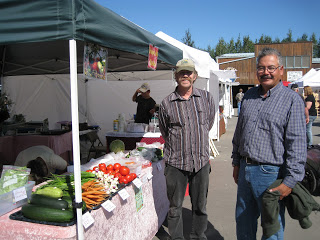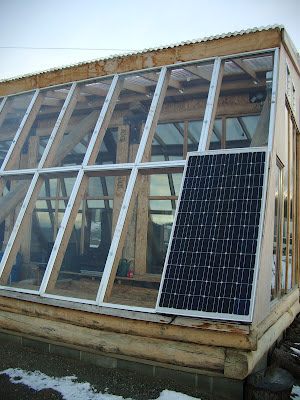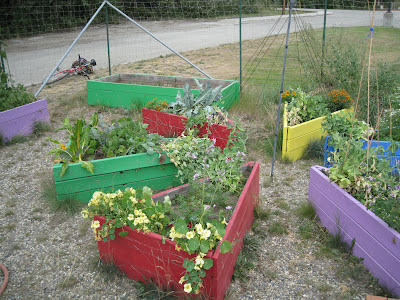A Lesson Plan for Gardening in the Classroom in Alaska, By Jessica Mulvey, An Alaska Master Gardener
“Where grows? Where
grows it not? If vain our toil, we ought to blame the culture, not the soil.’
-Alexander Pope
 |
| The Tanana Valley Farmers Market. Photo by Heidi Rader. |
Supporting local agriculture is not a ‘new’ idea in American
history. For generations there simply were no other options, but within the
last century Americans have distanced themselves — literally & figuratively
— from local agriculture. As Joel Salatin points out, “the average morsel of
food sees more of the world than the farmer who grows it, traveling an average
of 1,500 miles from field to fork.’ In Alaska, that mileage is almost guaranteed.
(Anchorage is approximately 1,450 miles from Seattle, WA.) However, the food
that you eat doesn’t have to earn more frequent flier miles than you! Mr.
Salatin poses an interesting question, “Imagine walking down the aisles [of the
supermarket], then ask yourself, ‘What could be produced within 100 miles of
here?’’ In Alaska that takes some
commitment — season extension tools, hardy varieties, etc. — but you may find
it is worth a little extra work to be a part of your local food system.
Subject Area: Social Studies
Grade Level: 7-12
Ideal season for lesson: Any
Time to complete lesson: 2-3 class periods
Materials Required:
Large sheets of blank paper
Colored pencils
CommunityGardens in Alaska
“Supporting
Farmers, Eating Local Food’ by Joel Salatin, Mother Earth News June/July 2012
Student Learning Objectives:
Know
the location of the nearest community garden.
Brainstorm
the nutritional needs of the local community & how those needs can be met
by a community garden.
Identify
other ‘waste space’ that could be used
for food production.
Recognize
season extension tools & techniques.
Analyze
the environmental and/or health benefits associated with “eating locally.’
Design
a garden.
Learning Activities:
Day One
Survey the class about their lunch. Ask, “What will you/did you eat for lunch
today?’ After 1-2 minutes, compile the results in a class list on the board.
Ask students to identify (this can be done by a student volunteer or by the
teacher) the items on the list that were grown locally. Ask the students how
they know or do not know that those foods were locally grown.
Development: Pass out copies of the
article “Supporting Farmers, Eating Local Food’ & read aloud as a class
& discuss.
discussion questions:
Looking back at the list of lunch foods on the board, is
there anything that wasn’t grown locally that you imagine could grow locally?
What would be required for that to be successful?
What is something that you frequently eat which could not
be grown locally? How do you know this?
What types of ‘season extension tools’ have you seen in
use in your community?
Is ‘seasonal eating’ an option for Alaskans?
What ‘waste space’ can you identify in your community/at
your school which could be used for gardening?
 |
| A well insulated greenhouse in Chickaloon, Alaska that can be heated using solar power, wood heat, and wind power. Photo by Heidi Rader. |
Closure:
Ask the students to write down on a small piece of paper what they think is the
furthest food travels to get to Alaska. Make sure their names are on the papers
and collect for tomorrow’s class.
find the food item which traveled the furthest to get to Alaska. Be prepared to
share: what that item is; how far it traveled; and where it came from with the
class tomorrow.
Day Two
students to share where their ‘furthest food’ came from. Locate those places
& mark on the board. Compare the results to their estimates from yesterday.
Lesson
Development: Pass out the handout CommunityGardens in Alaska. Read the handout aloud, paying particular attention to the
Sample Planning Questions at the end. Divide the students into small groups
& give each group a large piece of blank paper and colored pencils. The
students have the remainder of the class period to plan a garden using ‘waste
space’ that they identified at the school or in the community. Depending on the
grade level of the students & the time the teacher wishes to allot to this
lesson, planning can be very detailed or as general as needed — ranging from
simple sketches of a garden to plans that include plant spacing, succession
planting, seed starting dates, etc.
Closure:
Display the results in the classroom.
Alaska Social Studies Standards:
change as new evidence is discovered; 4) understand that history relies on the
interpretation of evidence;5) understand that history is a narrative told in
many voices and expresses various perspectives of historical experience;
economic, cultural, social, and environmental events that have shaped the
history of the state, the United States, and the world;
decisions, and understand other traditions.
understanding the historical
recognize and demonstrate that various issues may require an understanding of
different positions, jobs, and personal roles depending on place, time, and
context; 5) base personal citizenship action on reasoned historical judgment
with recognition of responsibility for self and others; and 6) create new
approaches to issues by incorporating history with other disciplines, including
economics, geography, literature, the arts, science, and technology.
About Heidi Rader
Twitter •
